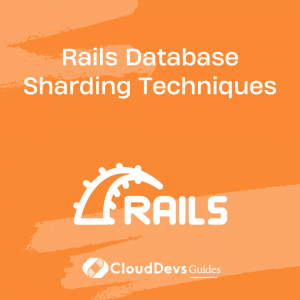Rails Database Sharding Techniques
Table of Contents
Rails database sharding techniques have become an increasingly popular topic among developers in recent years. As web applications continue to grow in scale and complexity, database sharding has become an important technique for scaling databases and ensuring high performance under heavy load. In this blog post, we’ll take a closer look at Rails database sharding techniques and how they can be used to build highly scalable applications.
First, let’s start with the basics. What exactly is database sharding? Simply put, database sharding involves dividing a database into smaller, more manageable pieces called shards. Each shard contains a subset of the data, and each shard can be hosted on a separate server or group of servers. By splitting up the data in this way, we can distribute the workload across multiple servers, which can improve performance and reduce the risk of downtime.
There are a number of different techniques for sharding databases, and the approach you choose will depend on a variety of factors, including the size of your database, the complexity of your application, and the specific performance goals you are trying to achieve.
In this post, we’ll explore some of the most common techniques for Rails database sharding.
1. Horizontal sharding
Horizontal sharding, also known as partitioning, involves splitting the data in a table or collection across multiple physical nodes. Each node contains a subset of the data, and queries are executed across all nodes in parallel. This technique is typically used when a single table or collection has grown too large to be handled by a single server, and is often used in conjunction with other sharding techniques to provide greater scalability.
In Rails, horizontal sharding can be achieved using the database’s built-in partitioning capabilities, or by using a gem like ActiveRecord Shard. ActiveRecord Shard provides a simple and easy-to-use API for sharding databases, and allows you to easily distribute queries across multiple shards.
2. Vertical sharding
Vertical sharding involves splitting a table or collection into multiple tables or collections based on columns or fields. For example, you might split a customer table into separate tables for basic customer information, order history, and billing information. This approach can be useful when certain columns or fields are accessed more frequently than others, or when certain columns or fields are too large to be stored in a single table.
In Rails, vertical sharding can be achieved using techniques like table partitioning or by using separate databases for different types of data. For example, you might use one database for customer information and another database for order history.
3. Key-based sharding
Key-based sharding involves dividing the data based on a specific key or set of keys. For example, you might shard a database based on user IDs or order numbers. This approach can be useful when you have a small number of high-traffic keys, as it allows you to distribute the workload across multiple servers and ensure that queries are executed quickly.
In Rails, key-based sharding can be achieved using a gem like Octopus. Octopus provides a simple and easy-to-use API for sharding databases based on specific keys, and allows you to distribute queries across multiple shards.
4. Hybrid sharding
Hybrid sharding involves combining multiple sharding techniques to achieve greater scalability and performance. For example, you might use horizontal sharding to divide your data across multiple servers, and then use key-based sharding to further divide the data based on specific keys. This approach can be useful when you have a large and complex database that requires a variety of sharding techniques to achieve optimal performance.
In Rails, hybrid sharding can be achieved using a combination of the techniques described above. By carefully considering your application’s needs and performance goals, you can design a sharding strategy that is tailored to your specific requirements.
In addition to these techniques, there are a number of best practices and considerations to keep in mind when implementing database sharding in Rails applications. Here are a few tips to help ensure that your sharding strategy is effective and efficient:
Plan ahead
Sharding a database can be a complex and time-consuming process, so it’s important to plan ahead and carefully consider your requirements before getting started. Make sure that you have a clear understanding of your application’s data requirements and performance goals, and choose a sharding technique that is well-suited to your needs.
Use a load balancer
When using horizontal sharding, it’s important to use a load balancer to evenly distribute queries across the available nodes. This can help ensure that each node is used efficiently and that queries are executed quickly.
Monitor performance
As with any complex system, it’s important to monitor the performance of your sharded database regularly. Keep an eye on query times, server utilization, and other metrics to ensure that your sharding strategy is working effectively.
Be mindful of consistency
Sharding a database can introduce new challenges when it comes to ensuring consistency across the data. Make sure that you have a clear understanding of your application’s consistency requirements, and choose a sharding technique that can meet those requirements.
Consider data migration
When sharding a database, it’s often necessary to migrate data from the original database to the new shards. Make sure that you have a plan in place for migrating data, and test your migration strategy thoroughly before going live.
In conclusion, database sharding is an important technique for scaling large and complex databases in Rails applications. By carefully considering your application’s requirements and performance goals, and choosing a sharding strategy that is well-suited to your needs, you can build a highly scalable and efficient application that can handle even the heaviest loads. Remember to plan ahead, monitor performance, and be mindful of consistency, and you’ll be well on your way to building a successful sharded database in Rails.



